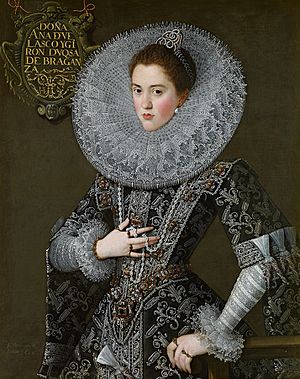Juan Pantoja de la Cruz facts for kids
Quick facts for kids
Juan Pantoja de La Cruz
|
|
|---|---|

Portrait of Prince Philip Emmanuel of Savoy (1586–1605), painted around 1604.(Bilbao Fine Arts Museum)
|
|
| Born |
Juan Pantoja de La Cruz
1553 |
| Died | 26 October 1608 (aged 54–55) Madrid, Spain
|
| Nationality | Spanish |
| Known for | Court painter |
Juan Pantoja de La Cruz (born 1553, died 1608) was a famous Spanish painter. He was known as a court painter, meaning he painted for kings and queens. Juan Pantoja worked for two Spanish kings, Philip II and Philip III. You can see some of his serious and detailed portraits in the Museo del Prado in Madrid.
Early Life and Career
Juan Pantoja de La Cruz was born in 1553 in Valladolid, Spain. We don't know much about his early years as a painter. He learned from Alonso Sánchez Coello, who was also a court painter in Madrid. Pantoja likely helped his teacher with paintings for King Philip II.
After finishing his training, Pantoja probably kept working in his teacher's studio. He got married in 1585 and started painting for the royal court around that time. When Sánchez Coello died in 1588, Pantoja took over his workshop. He then became the official court painter for King Philip II.
Painting for the Royal Family
Pantoja continued to paint for the royal family and other important people. He painted portraits of Prince Philip, who would later become King Philip III, in 1592 and 1594. One of his most famous works is a portrait of King Philip II. This painting, made around 1594, shows the king wearing a black cape and hat. It was created for the Escorial, a royal palace and monastery.
This portrait shows the idea of Spanish royalty very well. It makes the king look distant and powerful. When King Philip II died in 1598, his son Philip III became king. Philip III kept Pantoja as his court painter. In 1601, the court moved to Valladolid, and Pantoja moved there too. He stayed in Valladolid for several years.
Juan Pantoja de la Cruz painted many official portraits. He had a large studio with assistants and apprentices who helped him. He mostly painted the royal family, traveling with them to places like Valladolid, Burgos, Lerma, and the Escorial. He also painted portraits of important noble families.
Pantoja also created religious paintings. Many of these were ordered by Queen Margaret of Austria, who was King Philip III's wife. His religious paintings often included portraits of people. For example, in "The Birth of the Blessed Virgin" (1603), he included the Queen's mother. He also painted still lifes and ceiling frescoes, but these have not survived. Pantoja returned to Madrid with the court and died there on October 26, 1608.
Pantoja's Artistic Style

Pantoja followed a long Spanish tradition of royal portrait painting. This style began with famous artists like Titian, who painted Charles V. Artists like Antonis Mor, Alonso Sanchez Coello, and Pantoja continued this tradition. Some art historians used to criticize Pantoja's art. They thought non-Italian portraits were not as good. They called him "uninspired" or "dull," even though he worked very hard.
However, later artists like Diego Velázquez used similar ideas for their own royal portraits. Pantoja's portraits were often made in several versions. His assistants helped him with many of these. In his best works, Pantoja combined elegance with strong shapes. He used bright lights and deep shadows to create a powerful effect.
His portraits are known for their amazing detail. He carefully showed the fancy embroidery on dresses and the designs of jewelry. The person in the painting usually stands against a dark background. Their face and hands are painted with a softer, smoother technique. Some of his famous portraits include:
- King Philip III
- Queen Margarita of Austria (1606, in the Prado Museum)
- Infanta Isabel Clara Eugenia (1599, in the Alte Pinakothek, Munich)
- Duchess of Braganza (1603)
- D. Diego de Valmayor (1605, in the Hermitage, St Petersburg)
Pantoja was very successful as the leading portrait painter of his time. He was also a very skilled artist in many other areas. He painted religious scenes, mythological stories, and historical events for the Spanish court and noble families. His religious paintings often had a more realistic and dramatic style than his portraits. They sometimes showed a style called tenebrism, which uses strong contrasts of light and dark, similar to the Baroque style.
Juan Pantoja de la Cruz was also highly regarded for his animal paintings. He was known for painting landscapes and still lifes too. These types of art became popular across Europe in the late 1500s. Famous writers of his time, like Lope de Vega and Francisco de Quevedo, admired Pantoja's work. They wrote poems praising his talent. Lope de Vega wrote that Pantoja could "give almost life and soul to a silent face." Quevedo praised Pantoja's skill as a miniaturist, someone who paints very small, detailed pictures.
See also
 In Spanish: Juan Pantoja de la Cruz para niños
In Spanish: Juan Pantoja de la Cruz para niños
- Cultural depictions of Philip II of Spain
- Maria Kusche

